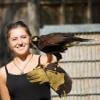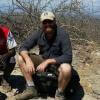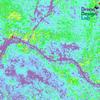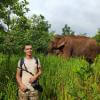Wildlife crime is one of the greatest challenges facing conservation, and one of the conservation tech world's biggest areas of innovation. With new ideas and solutions constantly being put forth to track and protect species targeted by poachers, manage protected areas and support rangers, and combat the growing online market for illegal wildlife products, the engineers and conservationists working to solve wildlife crime's many challenges rely on tools like machine learning, biologging, camera traps, acoustic monitoring, drones, mobile apps, and more.
This wide variety of overlapping technology makes our Wildlife Crime group a potential melting pot for many of our other communities, and makes it an especially exciting place to find collaborators working in different tech spheres to meet a common goal. Whether you're a camera trap expert looking for information on thermal vision to spot potential poachers, a machine learning expert with the skills to analyze acoustic data for gunshots, or a protected area manager seeking the latest integrated mobile tools, this group can connect you with the right members of our community!
Below, you'll find WILDLABS resources and conversations to help you understand how different technologies are being put to work in the fight against wildlife crime, and what conservation tech practitioners need for these tools to be effective.
Three Tutorials and Videos for Beginners:
- How do I use AI to fight wildlife crime? | Lily Xu, Tech Tutors
- WWF Wildlife Crime Technology Project | Eric Becker, Virtual Meetups
- SmartParks | Laurens de Groot, Virtual Meetups
Three Forum Threads for Beginners:
- Snare detection technologies | Rachel Kramer
- Tools for conservation management | Chris Muashekele
- Looking for Intelligence Database Software | Dexter Oelrichs
Three Articles for Beginners:
- Using AIS data to investigate the world's fishing ports, Max Schofield
- How do Wildlife Crime Experts view Remote Sensing Technologies used to Combat Illegal Wildlife Crime?, Isla Duporge
- Metal Detecting Sensors for Anti-Poaching, Sam Seccombe
Join this group now to get to know our community and start discussing solutions and ideas together!
Header photo: © Frank af Petersens/Save the Elephants
No showcases have been added to this group yet.
I am a forensic geneticist with a long term interest in developing and applying DNA markers to combat wildlife crime. Currently developing and validating STRs for raptors and rapid on-site species ID using the ONT MinION portable sequencer.
- 2 Resources
- 0 Discussions
- 5 Groups
- @Gody
- | He
Godfrey Nyangaresi, a dedicated Protection Manager with 12+ years of wildlife conservation experience. Skilled in technologies, administration, and law enforcement, he leads protection efforts at STEP, ensuring the sustainable conservation of elephants in southern Tanzania.
- 0 Resources
- 3 Discussions
- 17 Groups
- @RHugtenburg
- | He/They
Student at Aberystwyth University. Bug Fanatic🪲. Worked at Octophin Digital for my industrial year placement 🐙.
- 0 Resources
- 0 Discussions
- 19 Groups
- @kadambarid
- | she, her, hers
Dr. Kadambari Devarajan is an engineer-turned-ecologist working on biodiversity monitoring. (Website - http://kadambarid.in/)
- 0 Resources
- 0 Discussions
- 14 Groups
- 1 Resources
- 0 Discussions
- 12 Groups
- @samarmstrong
- | She/her
International Union for the Conservation of Nature (IUCN)
Invasive species/law enforcement/project management/Asia/Australia

- 0 Resources
- 0 Discussions
- 4 Groups
- @brittanypalmer
- | she/her
Entrepreneur and environmental attorney with a passion for wildlife conservation.
- 0 Resources
- 0 Discussions
- 4 Groups
- 0 Resources
- 2 Discussions
- 1 Groups
- 0 Resources
- 2 Discussions
- 2 Groups
Entrepreneur building AI-driven acoustic monitoring technology for comprehensive wildlife conservation, protection and ecosystem health monitoring.

- 0 Resources
- 0 Discussions
- 4 Groups
University of Madras
Research Coordinator
- 0 Resources
- 2 Discussions
- 1 Groups
Forgotten Parks Foundation
- 0 Resources
- 3 Discussions
- 5 Groups
SMART combines a ranger-based data collection tool with capacity building and a suite of best practices aimed at helping protected area and wildlife managers better monitor, evaluate and adaptively manage their...
15 March 2016
When Victoria Espinel, President and CEO of BSA | The Software Alliance, spoke at the WWF Fuller Symposium, she took us on a whistle-stop tour of case studies where software and data are transforming our understanding...
10 March 2016
We are living in the midst of a pretty exciting era. Never before has humanity been more educated, more connected, more enabled, or more empowered than we are today. There are many reasons to be optimistic about the...
17 February 2016
New horizon scanning report published this month identifies 15 emerging threats and opportunities for global biodiversity.
3 February 2016
From artificial “sniffer” technologies to portable DNA sequencers, the Wildlife Crime Tech Challenge received hundreds of innovative ideas to help stamp out wildlife crime. Now, the Challenge is proud to announce 16...
22 January 2016
Gary Atkinson, Director of Emerging Technologies at ARM, explains why we should be interested in the Internet of Things. Could it be a game changer for conservation?
10 December 2015
Can games have real world impacts on issues like the illegal wildlife trade? In part two of his case study for the Gaming for Conservation Group, Peter Jacobs discusses United for Wildlife's efforts to engage young...
3 December 2015
The 2015 Fuller Symposium brought together thought leaders in science, policy, business, conservation and development to tackle emerging issues facing our planet. This framing piece was developed to support a Fuller...
26 November 2015
Article
Traceability (knowing where products come from and how they are made) is a foundational pre-cursor for many sustainability interventions. While many tools have been developed to offer high-level insight about the...
26 November 2015
Can games raise awareness of conservation issues like the illegal wildlife trade? In part one of his case study for the Gaming for Conservation Group, Peter Jacobs discusses how United for Wildlife is partnering with...
25 November 2015
Article
Environmental DNA (eDNA) is nuclear or mitochondrial DNA that is released from an organism into the environment. Sources of eDNA include secreted faeces, mucous, gametes, shed skin, hair and carcasses. In this article,...
2 November 2015
September 2025
January 2023
December 2018
event
November 2018
event
42 Products
1 R&D Projects
42 Organisations
Recently updated products
Recently updated R&D Projects
Recently updated organisations
| Description | Activity | Replies | Groups | Updated |
|---|---|---|---|---|
| Hey Xiona,I see that you are from a university that is very close to where I live. I have a platform that is well suited for combating wildlife crime and I perceive that it’s... |
+5
|
Wildlife Crime, Acoustics, Latin America Community | 7 months 2 weeks ago | |
| Hats off to your team for this absolute game-changing technology! We rescue stray and wild animals in Taiwan, and the bulk of our work is saving animals maimed by wire snares... |
+37
|
AI for Conservation, Drones, Emerging Tech, Human-Wildlife Coexistence, Wildlife Crime | 8 months 3 weeks ago | |
| Because spotting the trucks on the roads is trivial. You could do it from 150m or further away in complete darkness. If this interests someone then I have a solution to do that. |
|
Wildlife Crime | 10 months ago | |
| Thanks, we know they are breeding these animals here, I asked, since it's seems to be an expensive hobby, we need to allocate more funding for rural women in entrepreneurship and... |
|
Acoustics, Animal Movement, Citizen Science, Human-Wildlife Coexistence, Protected Area Management Tools, Wildlife Crime | 10 months ago | |
| Re:Wild and some of their partners have set up SMART (www.smartconservationtools.org) at several locations in the Caribbean, e.g.,and WCS has successfully implemented SMART-based... |
|
Wildlife Crime, Conservation Tech Training and Education | 11 months 1 week ago | |
| Hi all,maybe it helps 😉 My free manual 'Drones in Biomonitoring' - https://doi.org/10.5281/zenodo.8077113 can help to get (more) knowledge how to proceed easily and successfully... |
|
Drones, Marine Conservation, Wildlife Crime | 1 year ago | |
| This is great!!!!! Thank you for sharing |
|
Wildlife Crime | 1 year 1 month ago | |
| Hello guys,I'm looking into the topic of measuring species vulnerability to overharvesting of species in trade. I am exploring existing... |
|
Ending Wildlife Trafficking Online, Marine Conservation, Wildlife Crime | 1 year 2 months ago | |
| I am interested in expanding our capability and understanding of snare detection by canines. We have two canines working in Asia that have successfully detected snares in training... |
+16
|
Wildlife Crime | 1 year 4 months ago | |
| Hi Scott, thanks so much for sharing your thoughts here! It would be great to learn more about this, would you be interested in finding a time to chat? Thanks! |
|
Marine Conservation, Sustainable Fishing Challenges, Wildlife Crime | 1 year 5 months ago | |
| Hi Danilo. you seem very passionate about this initiative which is a good start.It is an interesting coincidence that I am starting another project for the coral reefs in the... |
|
Acoustics, AI for Conservation, Animal Movement, Camera Traps, Citizen Science, Climate Change, Community Base, Connectivity, Drones, Emerging Tech, Human-Wildlife Coexistence, Open Source Solutions, Sensors, Software Development, Wildlife Crime, Funding and Finance | 1 year 6 months ago | |
| Fire detection is a sort of broad idea. Usually people detect the products of fire, and most often this is smoke.Many home fire detectors in the US use a radioactive source... |
|
Community Base, Conservation Tech Training and Education, Data management and processing tools, Ethics of Conservation Tech, Human-Wildlife Coexistence, Open Source Solutions, Protected Area Management Tools, Sensors, Wildlife Crime | 1 year 6 months ago |















































